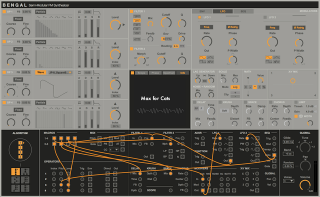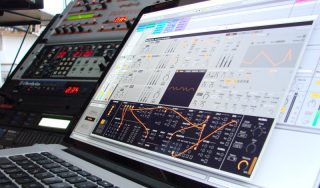Ableton, in conjunction with Max For Cats, has debuted Bengal, a Max For Live-based, polyphonic, semi-modular FM synthesizer.
Max For Cats says Bengal “combines the depth and textural intricacy of FM with the flexibility and free-form approach of a modular system.” Bengal boasts four operators, eight voices of polyphony, six FM algorithms, 20 editable sine wave harmonics (or one wavetable) per operator, six audio effects and a flexible modulation architecture centered on a graphically-interactive, virtual patch bay.
 Bengal, in-depth
Bengal, in-depth
Semi-modular and polyphonic. Bengal is a semi-modular synth: although its component modules (operators, filters, etc) are all fixed, they can be patched together in any preferred configuration, using the giant Patch panel at the bottom. The user can connect square output sockets to round input sockets by dragging virtual patchcords between them. Bengal is also eight-voice polyphonic.
‘Serious’ FM. Each of Bengal’s four identical operators generates its waveform using a bank of 20 editable sine wave partials or a wavetable – over 40 are included, and external samples can be imported by dragging and dropping them directly into the GUI. Independent ADSR envelopes with curve shaping and optional Looping are also in place for every operator, along with Feedback controls. The modulator/ carrier routing of the operators is chosen from a selection of six FM algorithms.
Dual filters. Bengal offers two multimode resonant filters with which to sculpt the output of the four operators. Filter 1 offers a choice of five switchable types – Moog- style ladder Lowpass, regular Lowpass, Highpass, Bandpass, Notch and Comb (with adjustable bipolar feedback) – as well as drive and wet/dry mix controls for dialing in “analogue-flavoured saturation” and parallel processing, respectively. Filter 2 can be placed after Filter 1 in the signal flow or fed in parallel with it, and morphs between Lowpass, Bandpass, Highpass and Notch types.
 Wild at heart. Modulation is key to Bengal’s architecture and sound. Running from 0.1Hz up to speeds in the audible range, the two LFOs serve as regular parameter modulators or additional FM sources, while both the six-segment Breakpoint envelope and ADSR envelope can be looped and curved. The eight-step sequencer can output MIDI notes or modulation data, and features scale snapping, swing, and randomization of pitch and velocity. Bengal’s four Modifiers enable the user to work with its modulation signals in various ways, including smoothing, scaling, applying mathematical functions, and four-way mixing. There are also six audio effects onboard – reverb, delay, distortion, chorus, limiting and stereo widening – for processing and polishing prior to the final output.
Wild at heart. Modulation is key to Bengal’s architecture and sound. Running from 0.1Hz up to speeds in the audible range, the two LFOs serve as regular parameter modulators or additional FM sources, while both the six-segment Breakpoint envelope and ADSR envelope can be looped and curved. The eight-step sequencer can output MIDI notes or modulation data, and features scale snapping, swing, and randomization of pitch and velocity. Bengal’s four Modifiers enable the user to work with its modulation signals in various ways, including smoothing, scaling, applying mathematical functions, and four-way mixing. There are also six audio effects onboard – reverb, delay, distortion, chorus, limiting and stereo widening – for processing and polishing prior to the final output.
Patching playground. Bengal has more than 50 modulation source parameters (including every individual LFO waveform and operator envelope, various MIDI messages and eight Macros, Max For Cats says – “ideal for use with the Ableton Push”) and over 60 targets (including the audio effects controls) available with the Patch panel.
See your sound. The Visual Control Panel, at the center of the Bengal interface, gives graphical feedback on the signal from any point within the synth, as set in the Patch panel. In Scope mode, the Panel shows the signal as a waveform; in Phase mode the stereo width and positioning are visualized; and in Spectrum mode, a sonogram reveals the frequency/energy distribution.
 A more in-depth walk-through of Bengal’s capabilities is here.
A more in-depth walk-through of Bengal’s capabilities is here.
Pricing and Availability. Max For Cats’ Bengal is available now for USD 59 / EUR 49 via Ableton’s online store. More information is available at Ableton.com.

I really want Ableton Live for this.
Max for Live makes Ableton even more modular than it already is. And this is a perfect example of this. Will buy eventually, already have Max for Cats virtual modular system Oscillot but haven’t spend enough time using.